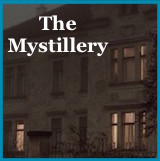dustjackets.com
About the author: (from Goodreads): Mignon Good (1899-1996) was born in Lincoln, Nebraska. In 1929 her first crime novel was published featuring 'Sarah Keate', a nurse and 'Lance O'Leary', a police detective. This couple appeared in another four novels. Over the next forty years she wrote a novel nearly every year. In 1971 she won the Grand Master award from the Mystery Writers of America.
Major characters:
- Mary Monroe, opera singer, roof
- August Tighe & Pigeon, 3rd floor
- Deborah Cavert, 2nd floor, & Annie, her cook
- Juliet Cavert, Deborah's aunt
- Gibbs and Chloe Riddle, 2nd floor
- Anthony Wyatt and Francis Maly, 1st floor
- Alfred & Dolly Brocksley, 1st floor
- Juanito Murphy, janitor
- Lieutenant Waggon, police detective
Building/apartment diagram:
| Roof: | Mary Monroe | |
|---|---|---|
| 3rd floor: | #5 vacant | #6 August Tighe & Pigeon |
| 2nd floor: | #3 Deborah & Juliet Calvert | #4 Gibbs & Chloe Riddle |
| 1st floor: | #1 Anthony Wyatt & Francis Maly | #2 Alfred & Dolly Brocksley |
Locale: Chicago
Synopsis: Deborah Calvert enters the vestibule of her apartment building to encounter Mary Monroe, a woman she does not recognize. Mary says she has misplaced her keys, and Deborah lets her in. Mary invites her up to her apartment for tea. It turns out her "apartment" is really a separate building on the roof, accessible only by fire escape - from the 2nd or 3rd floors, or from the ground*. The house is set back from all the walls, so is not visible from the ground.
Deborah and Mary go the 3rd floor, exit to the fire escape, and climb to the rooftop house, and have tea. Mary offers to sing for Deborah, if Deborah will accompany her on the grand piano. While doing so, an interior door in the house opens, a hand with a gun emerges, and shoots Mary. Deborah tries to call the police, but the phone - like Mary - is dead. The house intercom rings, and a man says he will be right up. It turns out to be first-floor tenant Anthony Wyatt, who tells Deborah to return to her apartment, and he will notify police.
It becomes evident (from lack of police response) that Wyatt did not call the police, and the body is not "discovered" until much later. Wyatt and Deborah are both afraid of being accused, and conspire to silence and pretend they were not present. Wyatt goes so far as to propose a marriage, so they would be unable to testify against each other.** Deborah accepts the idea, and upon leaving the apartment, discovers the body of Alfred Brocksley in the hallway.
Suspicion mounts against a couple of shady characters: August Tighe and his tough guy "secretary" (actually bodyguard) Pigeon. They occupy the apartment directly below the rooftop house.
Review:
The closed world of the apartment house and its tenants (most with secrets) spying on each other reminded me of Cornell Woolrich's short story Rear Window and the subsequent Alfred Hitchcock film of the same title.
This one was a puzzler. Especially the character of Anthony Wyatt: I could never figure out if he was the good guy who be Deborah's ally and love interest, or a bad guy just using her for his own purposes. When we meet him, he is holding a gun and being menacing. He was just a mystery throughout - until the very last page. I thought I had the killer ID'd about halfway through, but ... I was wrong.
The character of Francis Maly definitely gave off gay vibes with his styled hair and stated affections for Anthony, even down to the ambiguous pronunciation of his name (Francis/Frances) - pretty bold for 1934. This misled me into discounting roommate Anthony as the eventual love interest for Deborah.
The reader would do well to keep the layout of the apartment house handy, as the locations of the apartments are central to the plot.
But the biggest mystery of all ... how did Mary Monroe get her grand piano up the fire escape in the first place?
*The fire escape exit doors on the 2nd and 3rd floors are spring-locked one-way in the usual manner, persons can only exit to the fire escape, but not enter the building from the outside.
**This is a common misconception. In reality, the provision that a husband may not be compelled to testify against a wife, and vice versa, known as spousal privilege; only applies to testimony about communications or events that occured during the marriage. Thus, each can be compelled to testify against the other concerning communications or events which occurred prior to (or even after a dissolution of) the marriage. Source: Legal Information Institute. So entering into a marriage just to avoid this sort of predicament would not work, but it makes a good plot element. Erle Stanley Gardner always got it right, but then again, he was a lawyer! He used it a number of times to trip up witnesses.
For a similar rooftop adventure, try The Bungalow on the Roof by Achmed Abdullah (Mystery League, 1931).


No comments:
Post a Comment